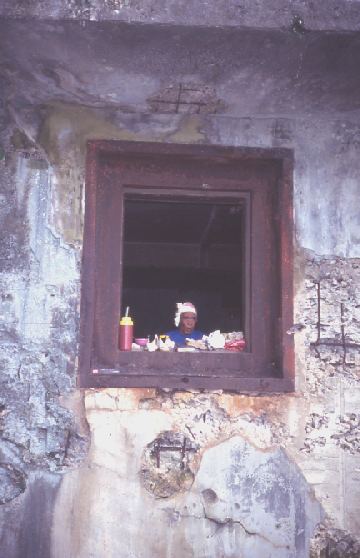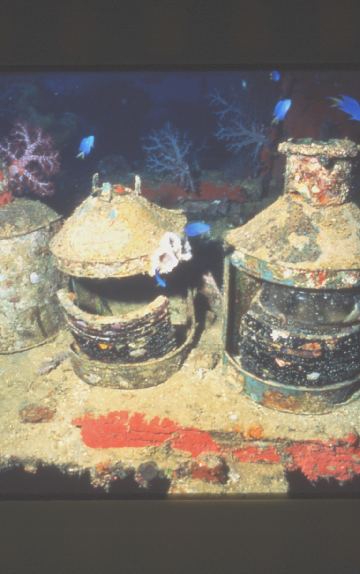After years of talking about it, there we were standing on a sandy beach underneath swaying palm trees gazing out over the ruffled waters of Truk Lagoon. Steve, Paul, and I had finally made it to the wreck divers heaven. Just off shore, gently at anchor, lay a large steel boat its white paint gleaming in the sunshine. This was the Truk Aggressor, our home for the next six days.

If you are going to fly thousands of miles to dive your dream then you might as well do it in style, and the Aggressor has plenty of that, though it does not come cheap. However the price includes just about everything including all the beer you can drink, and an unlimited air supply. Well that’s what the brochure said though not having been on a live aboard before I was apprehensive. If the brochure was wrong my dream could soon turn into a nightmare. After a punishing flight from Guam, Steve, Paul, and I, had been met at Truk International Airport, (more a collection of lean-to sheds) by Lenny the skipper of the Truk Aggressor. He exuded efficiency and friendliness and we all took to him straight away. Soon we were bouncing down Truk’s only road in a battered Combi en route to the Intercontinental Hotel (motto, friends are also customers) were we would have a few cold beers and a snooze whilst Lenny and his crew finished refueling and cleaning the boat ready for our arrival. The outgoing passengers had said hullo at the airport, so it was a pretty tight schedule.

Once on board all my fears were immediately put to rest, we were introduced to the gorgeous Linda who besides taking all the P.A.D.I. courses and processing all our film, acted as the Mate and generally made our lives very comfortable. The lounge was huge, carpeted and panelled in a light oak, which with its large windows made this ‘room’ very relaxing and welcoming. Across the forward end was a large bar area with fridges containing wine, beer and plenty of soft drinks. At the other end the room was furnished with two huge semi circular sofa’s surrounding a video screen and a stack of the latest movies.
Down below were the cabins. We had thought that we would have to share, but with only fourteen guests on board,( they only take twenty when they are full ) we each had our own cabin with a double bunk, en suite shower and toilet, and a full sized wash basin. Dotted around the walls were lots of underwater photos. Everything was paneled or carpeted and whilst very practical the boat had the ambience of a good quality hotel. Up top was a vast sundeck with chairs and loungers. This area was also carpeted so that the deck did not fry your feet and had another bar area complete with coolers containing beer and soft drinks.

At the stern was the business end of the boat, the diving platform. This was on two levels and extremely well thought out. The main deck level had individual lockers for your fins and mask etc, with the tanks racked up all along the sides. A high pressure air system fed air to four hoses so that the crew could fill up all the tanks where they stood. A wire with hangers was fed around the underside of the sun awning, which allowed you to hang up all your gear to dry in between dives. Just outside the main lounge door was a large three tiered camera wet table and a large briefing board. To get into the water you kitted up, handed your fins and camera to one of the crew, usually Charlie, and walked down three steps to the jump off platform which is only about a foot above the water. When you are ready you just step into the water, take your camera from the ever helpful Charlie and swim down to the wreck. After your dive you just reverse the process and climb up one of the two huge diving ladders. Your gear has already been placed in a large freshwater tank at the rear of the platform and you are left washing the salt out of your hair under one of the freshwater showers. Nothing could be simpler, which is just as well because on our first dive brief Lenny told us that, if we wanted to, we could do five dives a day. Well, we certainly wanted to do that.

Over the next six days we dived thirteen of the twenty five wrecks inside the Lagoon, and on most days did four day dives and one night dive. This might seem a little relentless, but believe me, it wasn’t. The quality of the diving,(the wrecks were simply stunning) combined with the excellence of the dive boat, and the organization of Lenny, Linda , and the boys just made the diving seem effortless. A typical day started at around seven o’clock with a huge breakfast. Some of the choices were a bit unusual .Ham and eggs is ok, but porridge sprinkled with drinking chocolate ?? At eight o’clock the cry, dive brief , echoed throughout the boat , and Lenny or Linda would then tell us the dive program for the day and describe in detail the wrecks and any wrinkles that might be helpful to us. We were left pretty much to do our own thing dive wise. They did not even insist on us diving in pairs, and there was none of the herding around that we had all worried about. The only things that they were really strict on was drinking and diving, and they more or less insisted on you doing a ten minute safety stop. Since the nearest pot was at Guam this seemed to be a reasonable request. Diving insurance was obviously mandatory. There was also a large log board which Lenny liked us to use to log ourselves in and out of the water. This was a really good idea as it meant that he knew exactly where we all were and allowed us to dive at different times, so that quite often we had the wreck completely to ourselves.

There also seemed to be an agreement between all the dive boats in the Lagoon not to dive on the same wrecks so there was no crowding at all. We usually had a two hour interval between dives and if the boat needed moving to another wreck that’s when Lenny would do it. In order to manoeuvre the Aggressor over the wreck, Lenny had a small pad linked to his bridge controls that allowed him to wander all around the boat whilst steering it at the same time. He did not anchor on any of the wrecks for fear of damaging them . Instead, when he was right over the wreck he would send down Charlie who would look for a pre-arranged bollard, or a rope strop already in position. When he found it he would purge his mouthpiece, and when Lenny saw his bubbles coming up he carefully lowered the mooring rope down to Charlie who then secured the Aggressor to the wreck.

All through the day food of one sort or another appeared in vast quantities produced by our local cook, Tai. All bread and cakes were made on board, and his mission in life seem to be to add at least a stone to every ones body weight. At about eight in the evening the night diving commenced and by ten o’clock most of us were tucked up in bed tired out The boat stayed moored over the wreck at night to ensure a sound sleep. Your wake up call in the morning was the Aggressors diesels starting up at six forty five. Occasionally we would land on one of the islands to look at some of the old Japanese buildings, and one day we were very lucky to meet Kimio Aisak who came on board and gave us a talk. He was the first person to start diving on the wrecks, and had been on the islands when the Japanese invaded.

The diving conditions in the Lagoon were perfect. Water temperature was about eighty degrees Fahrenheit and the air temperature never less than ninety, but the boats air conditioning kept us all very comfortable. Although quite a wind blows through the islands, and torrential rain storms can come and go in a flash, the water is usually completely flat, so visibility stays around the sixty, to a hundred foot range. With no pollution the water stays extremely clear. Most of the wrecks are in just over the one hundred foot mark, with their main decks and superstructure in about fifty to seventy feet. Because of this you really will need a dive computer to take full advantage of the diving. Telegraphs and helms in the bridges are the norm, and a great abundance of crockery, shells, bullets, gas masks, Zero fighters, lorries, and even a tank lie scattered around the various wrecks in such a way as to give you perpetual heart failure. The ‘no take’ rule is strictly enforced and after a while you just do not want to take anything because somehow it would spoil it all.

Strangely some of the wrecks that we dived on were British ships bought by the Japanese before the War and converted to supply or repair ships. On one in the boiler room was a large brass plate with the makers name on it, and some of the pressure gauges still had English tally’s on them. Apart from the stunning beauty of the wrecks (there was just enough coral to make them pretty, but not enough to distort their features) it is their completeness that really amazes you. Racks of spanners neatly laid out in the engine rooms, blocks of drill bits in the machine shop, Medicine chests full of bottles, bath houses with their toilets and wash basins, submarine periscopes laid out in companionways. Some of the temperature gauge’s still have the mercury inside them, and in one compartment steel lampshade complete with bulbs still hang from the deck head. It was better than all our dreams and when the last dive had been done, and it was time to go, we had to be prized away from the Aggressor like spoilt children from a sweet shop.
